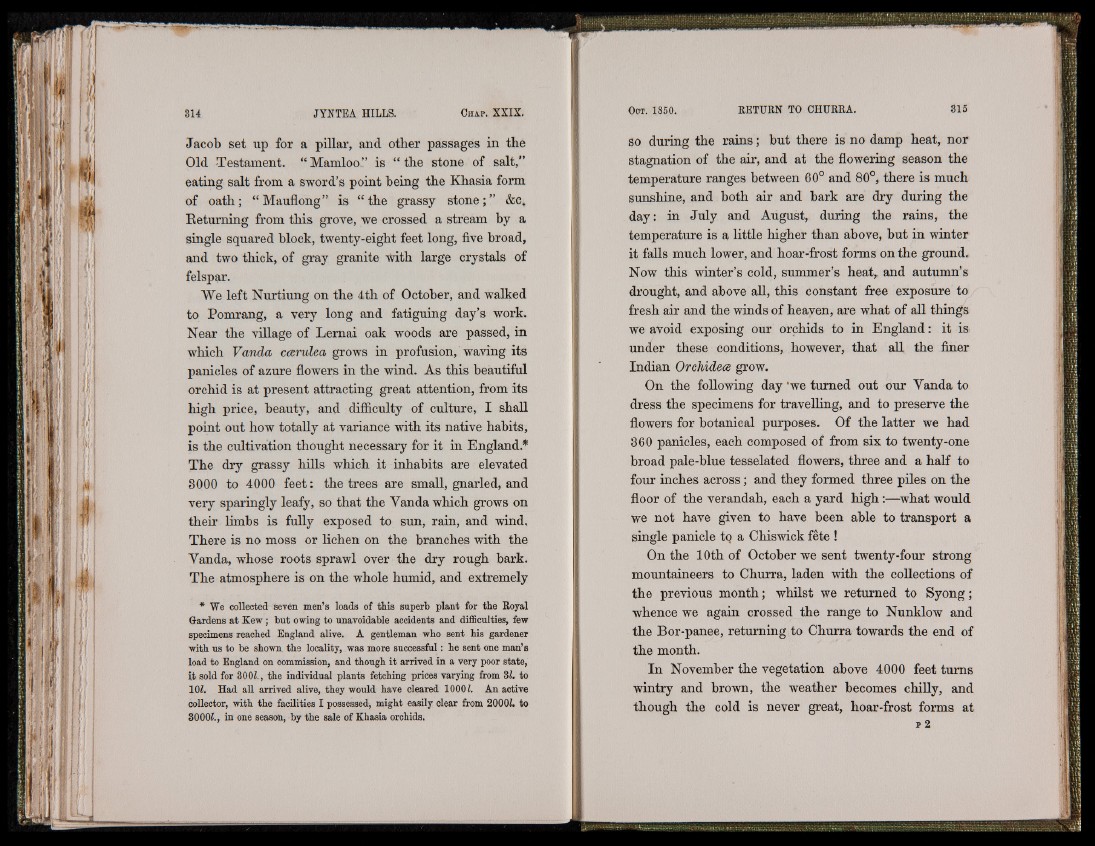
Jacob set up for a pillar, and other passages in the
Old -Testament. “ Mamloo” is “ the stone of salt,”
eating salt from a sword’s point being the Khasia form
of o a th ; “ Mauflong” is “ the grassy stone; ” &c.
Returning from this grove, we crossed a stream by a
single squared block, twenty-eight feet long, five broad,
and two thick, of gray granite with large crystals of
felspar.
We left Nurtiung on the 4th of October, and walked
to Pomrang, a very long and fatiguing day’s work.
Near the village of Lernai oak woods are passed, in
which Vanda carulea grows in profusion, waving its
panicles of azure flowers in the wind. As this beautiful
orchid is at present attracting great attention, from its
high price, beauty, and difficulty of culture, I shall
point out how totally at variance with its native habits,
is the cultivation thought necessary for it in England.*
The dry grassy hills which it inhabits are elevated
3000 to 4000 fe e t: the trees are small, gnarled, and
very sparingly leafy, so that the Yanda which grows on
their limbs is fully exposed to sun, rain, and wind,
There is no moss or lichen on the branches with the
Yanda, whose roots sprawl over the dry rough bark.
The atmosphere is on the whole humid, and extremely
* We collected seven men’s loads of this superb plant for the Royal
Gardens at Kew; but owing to unavoidable accidents and difficulties, few
specimens reached England alive. A gentleman who sent his gardener
with us to be shown the locality, was more successful: he sent one man’s
load to England on commission, and though it arrived in a very poor state,
it sold for 300L, the individual plants fetching prices varying from 31, to
10L Had all arrived alive, they would have cleared 10001. An active
collector, with the facilities I possessed, might easily clear from 2000L to
30001., in one season, by the sale of Khasia orchids.
so during the rains ; but there is no damp heat, nor
stagnation of the air, and at the flowering season the
temperature ranges between 60° and 80°, there is much
sunshine, and both air and bark are dry during the
day: in July and August, during the rains, the
temperature is a little higher than above, but in winter
it falls much lower, and hoar-frost forms on the ground.
Now this winter’s cold, summer’s heat, and autumn’s
drought, and above all, this constant free exposure to
fresh air and the winds of heaven, are what of all things
we avoid exposing our orchids to in England : it is
under these conditions, however, that all the finer
Indian Orchidece grow.
On the following day ’we turned out our Yanda to
dress the specimens for travelling, and to preserve the
flowers for botanical purposes. Of the latter we had
360 panicles, each composed of from six to twenty-one
broad pale-blue tesselated flowers, three and a half to
four inches across ; and they formed three piles on the
floor of the verandah, each a yard high :—what would
we not have given to have been able to transport a
single panicle to a Chiswick fête !
On the 10th of October we sent twenty-four strong
mountaineers to Churra, laden with the collections of
the previous month ; whilst we returned to Syong ;
whence we again crossed the range to Nunklow and
the Bor-panee, returning to Churra towards the end of
the month.
In November the vegetation above 4000 feet turns
wintry and brown, the weather becomes chilly, and
though the cold is never great, hoar-frost forms at
p 2